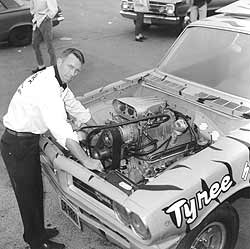| 
The reaction to Jack’s Comet set several people to
thinking that if you combined a Blown Nitro motor with something
stock-appearing and it was a real race car, you would have
a real crowd pleaser. Chrisman was the catalyst, but the class
now known as Nitro Funny Cars was started in the Chicago area
and by Independent Racers. The name “Funny Car”
came from the publicity pictures of the first altered wheelbase
Mopars which showed the cars with stock tires and wheels on
the back. After those pictures we are lucky they are not known
as Silly Cars.

Arnie “the Farmer”
Beswick (Jon Asher photo) |
You will notice I said NITRO FCs, as using anything other
than Nitro was not considered a Funny Car until NHRA created
the Alky FC class about 20 years later. The first three Supercharged
Nitro Funny Cars built as race cars were Ron Pellegrini---Arnie
Beswick----Gary Dyer/Mr. Norm all with in a 100 miles radius
of Chicago.
For the record I was running the Dyno at Grand Spaulding
Dodge (Mr. Norm) at the time as well as being friends with
Beswick so I knew all the players. Ron Pellegrini took a tube
frame Supercharged Fuel altered and mounted his own Fiberglass
Mustang body; to say he was ahead of the time would be a huge
understatement. Beswick had the blower on his GTO by now but
was running of all things “gasoline” with me calling
him every 15 minutes trying to get him to go with Nitro.
As I was working at Mr. Norms, I watched Gary Dyer building
the first of many Mr. Norm Nitro FCs. This first car was not
factory backed and in fact Norm (soon to be the biggest selling
Dodge dealer in the US) was told by Dodge not to build it.
I had left Norm’s to crew chief on Arnie’s GTO
and to convert it to Nitro with the promise of driving a second
car to be built later that year. (Old Fuel Dragster guys were
in big demand during the early FC days).
So by June of 65 the first three 3 Supercharged Nitro FC
were running and then something happened that would change
drag racing for ever. Track owners/promoters started to call
wanting to pay money to have Nitro FCs at their track as the
Fans were wild about them. If you hired Nitro FCs, your track
made money. It was as simple as that.
For whatever reason (probably because it was too radical
for the time) Ron Pellegrini’s Mustang-bodied fuel altered
never gained the recognition it deserved, but both the Mr.
Norm Dodge and Beswick’s GTO were in such demand they
could have had paid race dates five days a week.
During this same period the factories were hiring/building
and promoting Injected Nitro FCs to showcase their brands.
In most cases the factory cars were about one half to one
sec and 20 mph slower than the supercharged independents.
The factory injected cars, while having hundreds of magazine
stories written about them, were not major players in the
real world where bookings were decided by both performance
and popularity.
During that year the blown cars mainly raced each other as
the factories wanted no part of this. By the next year their
were several new blown cars added to the show including Lew
Arrington’s “Brutus” and Steve Bovan’s
“Blair’s Speed Shop” both from California,
Dale Creasy Sr. from Chicago, Al Vanderwoude’s “Flying
Dutchman” from Kansas and Bobby Wood from Alabama.
In 1966 Ford got a little tired of the independent blown
cars making their factory cars look like red- headed step
children and the Mercury division fired back with the Logghe-built
tube frame one piece fiberglass-bodied 427 SOHC Comets.
While Nicholson and Schartman were still on injectors, at
1740 lbs they were a match for the heavier blown cars—that’s
for sure.
In my next feature, we may go on thru the “Golden”
years of Nitro FC match racing and I will tell what ended
it then and what may bring it back again.
|
